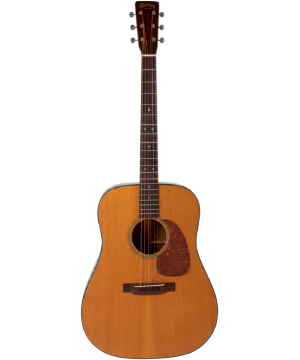Posted on Saturday 10th October 2015
 Having talked about the pre-war Martin D-28 in last month's issue, I thought it would be a good moment to featurea dreadnought from the series of guitars that Martin started making in the 1850s and have produced continually ever since: the Style 21 guitar. The feature this month is a first-year-of-issue 1956 Martin D-21.
Having talked about the pre-war Martin D-28 in last month's issue, I thought it would be a good moment to featurea dreadnought from the series of guitars that Martin started making in the 1850s and have produced continually ever since: the Style 21 guitar. The feature this month is a first-year-of-issue 1956 Martin D-21.
You don’t find many 21s around so it’s not easy to determine what makes them structurally or sonically different from the 18 or 28 series. It’s kind of the ‘mystery’ group that doesn’t fit in with the average player’s vocabulary of classic martin guitars. Yet, throughout their long history, it has proven to be one of their most successful series, produced since before the civil war in varying models.
Intended to be Martin’s least expensive rosewood series, it remained in that position until the mid-1990s, whereupon martin began production of some style 16 models in rosewood.
What you have with style 21 is, other than the soundboard and neck, a guitar made completely from rosewood. Rims, back, fingerboard and bridge are all rosewood, unlike the 28 series, which uses ebony for its board and bridge. Now, you might say ‘so what?’ but I can say with confidence that the difference is tremendous.
Ebony is considerably more dense than rosewood, so any guitar using it in the positions mentioned will invariably have a much crisper, louder tenor with a very quick response. Together, the two woods saturate the air with huge, complex tones. ‘Big’ is a pretty inclusive word to describe it.
Rosewood on the other hand (and in this instance Brazilian rosewood) is softer and has less density, therefore creating a sound (when used in the positions mentioned) that has a rounded, silkier character with greater warmth and an attractive woody texture.
So what do we have in the D-21 featured in this article? it is basically a hybrid guitar that sonically lies between a mahogany bodied D-18 and a Brazilian rosewood D-28. The body is solid Brazilian rosewood with a solid Honduran mahogany neck that has no volute at the nut. The fingerboard and bridge are solid Brazilian rosewood as well and the top is solid Sitka spruce. The bracing is straight and of sitka spruce. The headstock is veneered Brazilian rosewood and the tuners are Kluson single-line closed backs with nickel-plated buttons. The rims are adorned with faux-tortoise bindings and it also has a beautiful butterscotch colored faux-tortoise pickguard only found in the early to mid-50s era. a checkerboard back-strip completes the appointments. This particular guitar has the most straight-grained tonewoods available with a beautiful, caramel-like color (unlike the dark, ruby colored Brazilian woods found most of the time). it has the small, maple bridge plate and standard X-bracing with a 1 5/8” nut width. The guitar is crack free and in its original state.
Tonally, the 21 series of guitars tend to have all the volume of a D-28 along with a lingering sustain, complex harmonics and bags of backtone – all characteristics of the Brazilian rosewood body. However – and here is the important thing about the 21 series – the tone and sound of this guitar is absolutely sublime, attributable to the aged Brazilian rosewood fingerboard and bridge.
These appointments blend the warmth and vocal controllability of a great D-18 with the power and willingness of the Brazilian D-28. Tactile and woody with a crisp yet more subtle attack and a presence that isn’t muddy or unclear, the D-21 is more controllable than the big, broody D-28. I have experienced many examples of the 21 series and they are consistent and completely unique from this perspective.
Amazingly, the sustain is as good as an ebony-appointed dreadnought but carries with it the colourful and warm tone of a mahogany-bodied guitar. You will find the rounded voice of great benefit in controlling the ‘vibronics’ normally associated with Brazilian bodied guitars. It is a delight to play with less to dampen and more to just let run on. Because of its hybrid genetics, it is fully capable of filling the air with a beguiling and well- presented sound you can listen to till the cows come home.
If the D-18 is too woody in a mahogany way and the D-28 is too big and uncontrollable, then the martin D-21 – and the entire 21 series of guitars – is something to consider. Their complexity is enlightening and very rewarding.
For details about this guitar click here.
Reproduced with kind permission of Acoustic Magazine